Journey to Espana
May 26 - June 9, 2017
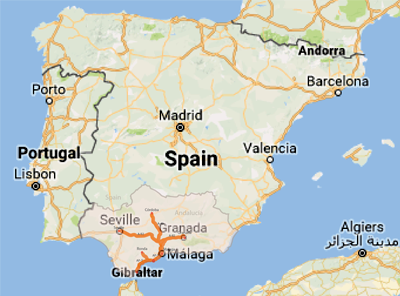 | It was a journey for which the time had come. Rod had been working with Manuel Olmo of Seville, Spain for six years as Manuel expertly translated the material of the HyperPhysics website. It was for the development of the Spanish version of HyperPhysics on the web for worldwide distribution. Rod very much wanted to meet Manuel and find some way to honor him for his work. Chris Suarez had just graduated from high school, and it seemed like a great opportunity to take him along for that experience and for his help in translating and communicating in Spanish. |

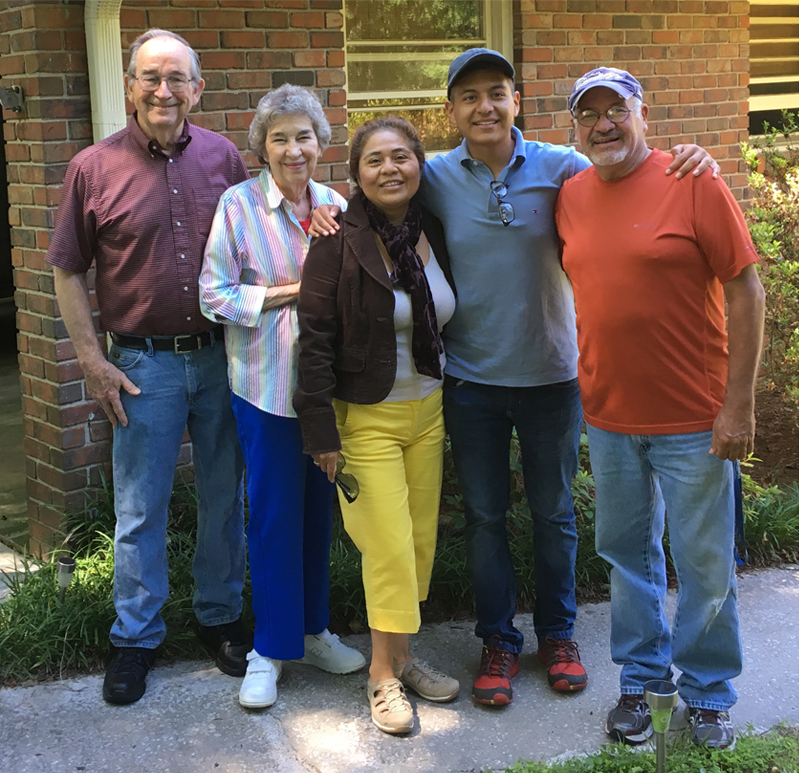
Rosa and Angel Suarez brought Chris over and then took us to the International Terminal of Atlanta Airport.
Brenda, Rod and Chris Suarez left Atlanta at 3pm on Friday, May 26 on a Delta flight to Amsterdam. The plane was a big modified airbus and we were in the middle of it, so no opportunities for photos on that flight. With a six hour advance in the time zones on that trip, we landed in Amsterdam just after 5am on May 27. I noticed that we had a 170mph tailwind at one point, so that helped. The distance was shown as 4386 miles. We had a layover until 12:30pm when we left on a KLM flight to Malaga, Spain.
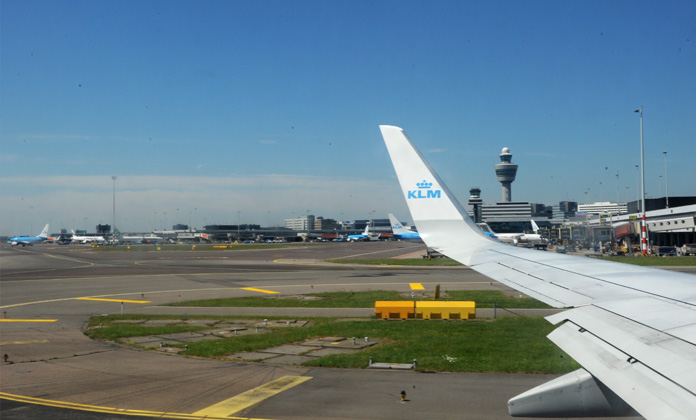 | I had a window seat on the KLM flight, so I observe when we are taxiing out for takeoff from Amsterdam. |
We lift off from Amsterdam. The time is 12:46pm which I will use as a marker for the time of the flight. |  |
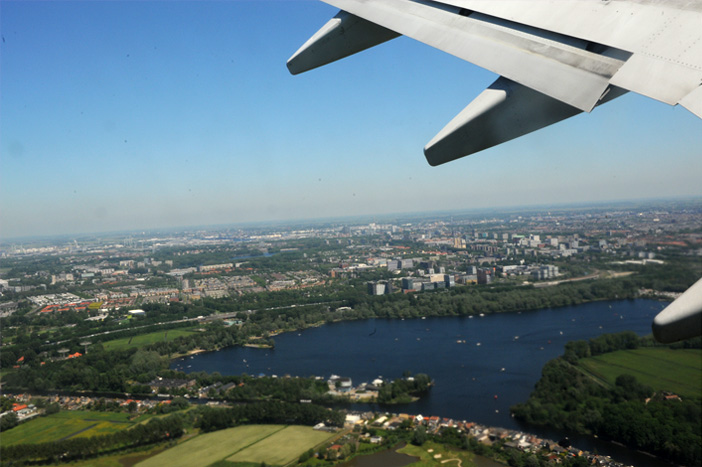 | We moved almost immediately over a more urban area, which I presumed to be a part of the city of Amsterdam. 12:46. |
Apparently a dense residential area, but from the size of the highway, presumed close to urban Amsterdam. 12:46 | 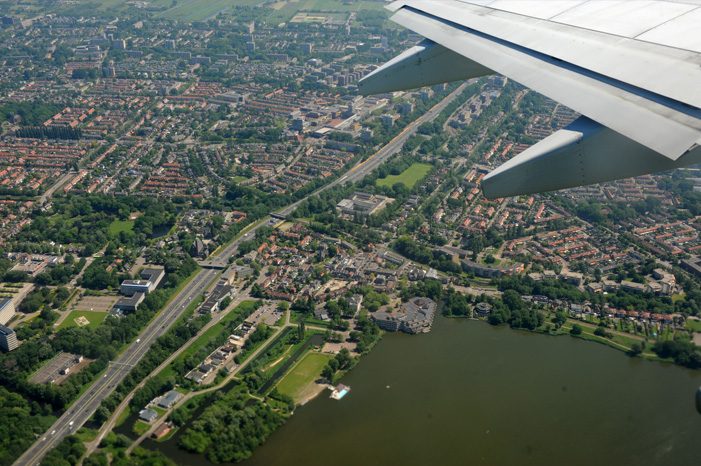 |
 | Over an intensely cultivated farming area along a river. 12:47 |
The rivers would appear to be a part of the agricultural effort, but I don't see large scale irrigation structures. 12:47 | 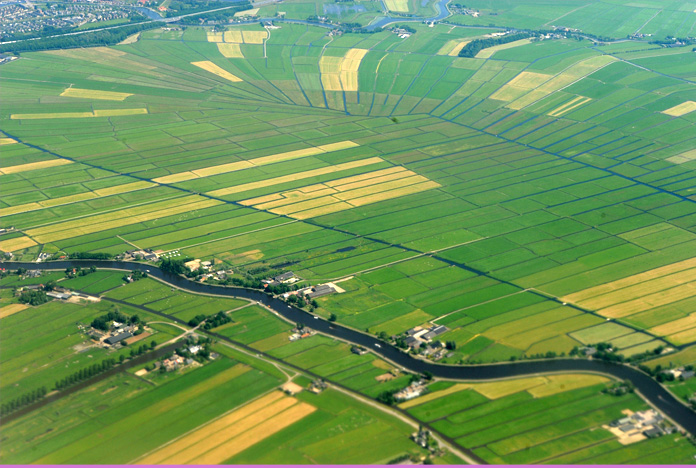 |
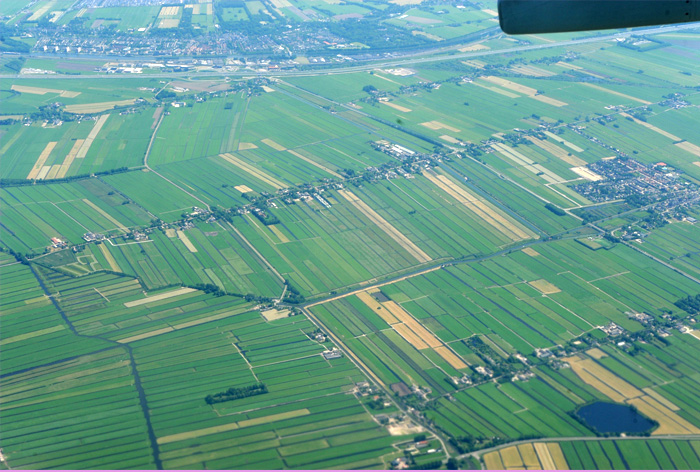 | Wider view of the agriculture as we gain height. 12:49 |
I was interested in the town alongside the river. Still an intense agricultural area. Note the many houses along what appears to be a canal. 12:51 | 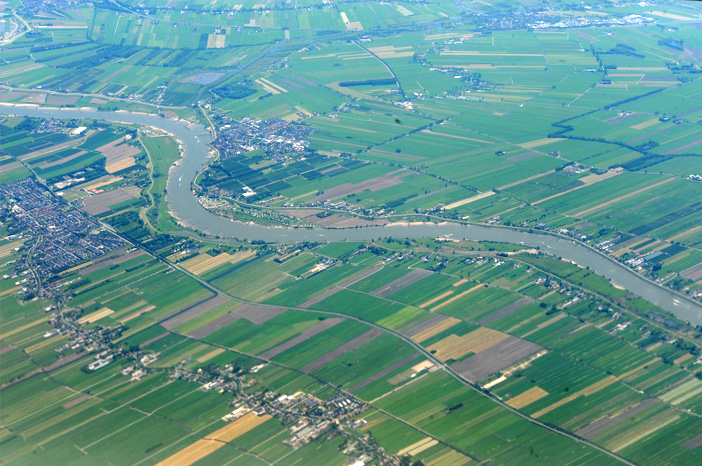 |
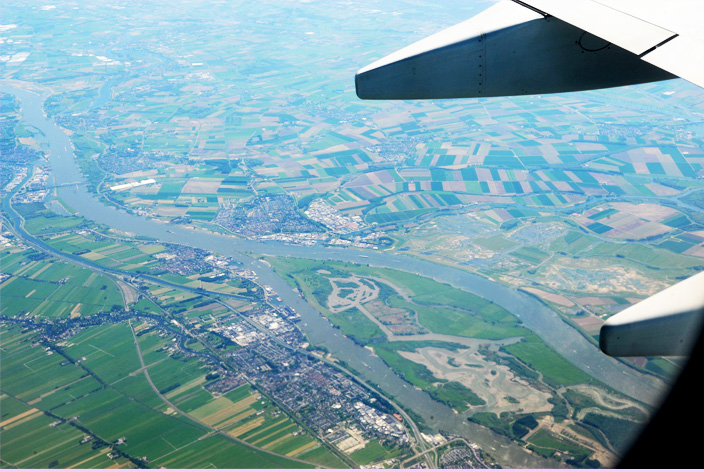 | Interesting river branch. More evidence of concentrating the housing along the waterways to preserve the open land for intensive agriculture. 12:52 |
A very different pattern of agriculture along this river, and the housing can be seen to be more distributed into the agricultural land. 2:00 pm, 1hr 14min into flight. | 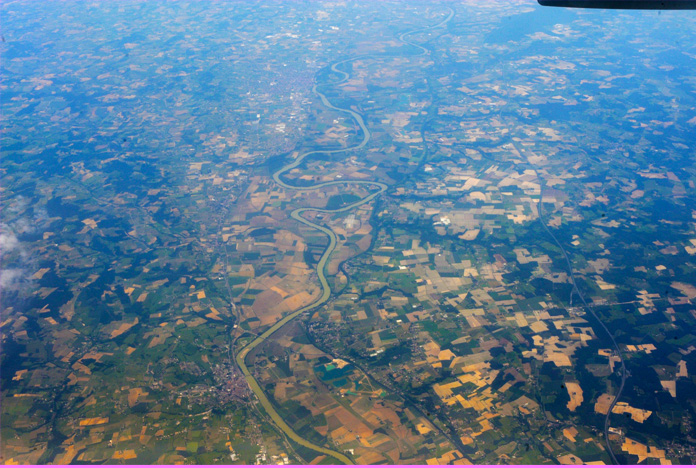 |
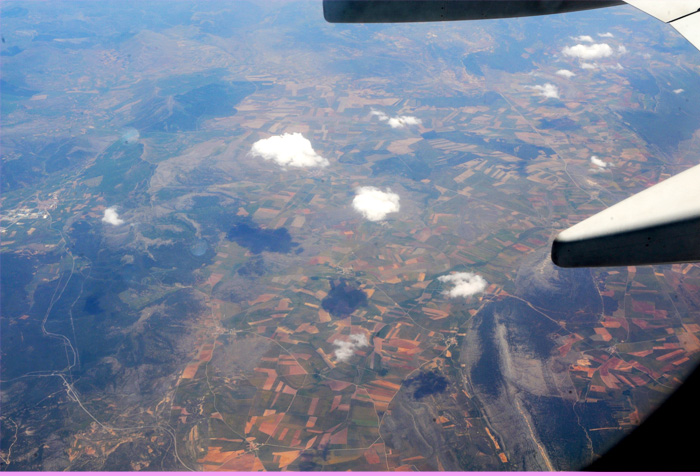 | This appears to be a much drier area with a variety of agriculture. 2:27pm, 1hr 41 min into flight. |
Interesting cloud patterns over this drier terrain. 2:29pm, 1hr 43 min into flight. | 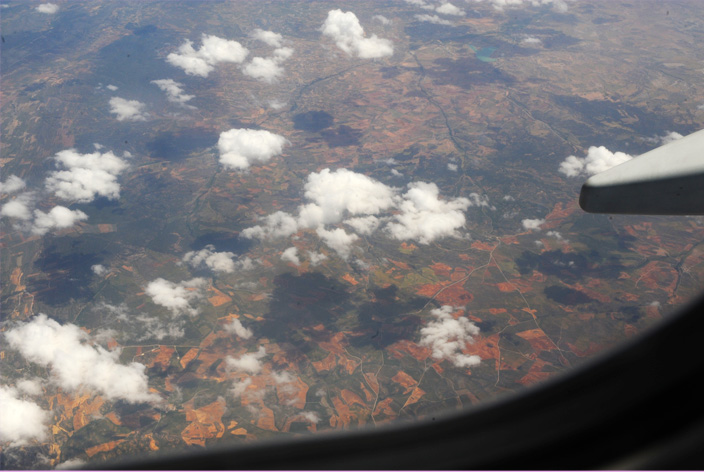 |
 | As I was looking down, I saw this other plane come zipping along below us. It appeared to be at about a 30 degree angle from our flight path. 2:56 pm, 2hr 10 min into flight. |
You can see the dam at the end of this extensive reservoir. The outflow from the dam flows into the river. There is a lot of evidence of irrigation on the south side of the river. 3:05pm, 2hr 19 min into flight. |  |
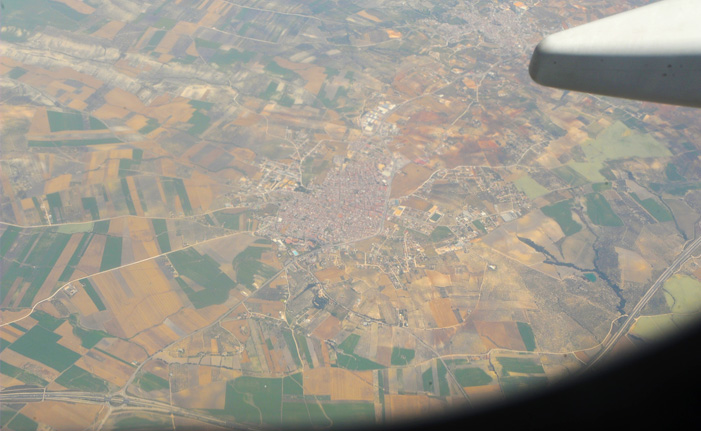 | This small city seems to be in a drier area. 3:08 pm, 2hr 22 min into flight. |
In this dryer area you can see the grid pattern of the olive trees. I had seen it in the book. 3:11pm, 2hr 25 min into flight. | 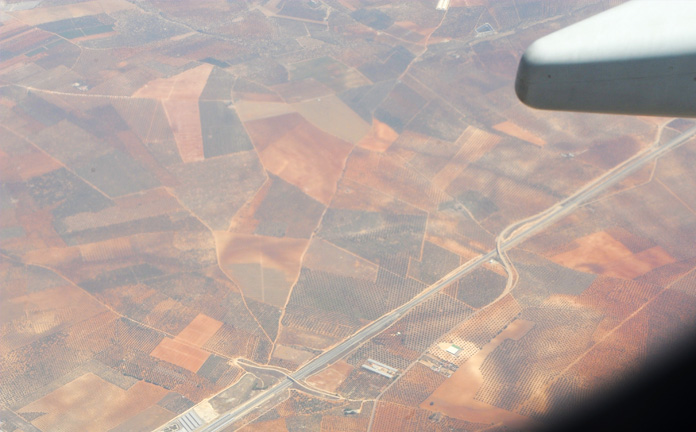 |
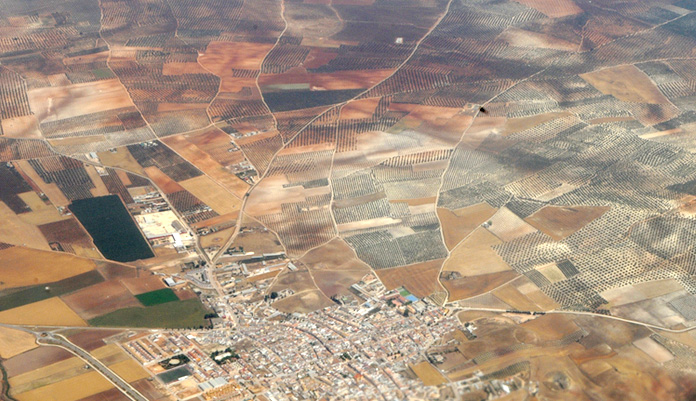 | The patterns of the olive trees around this city shows the predominance of olive growing in the area. |
This closer view of an olive grove also shows three large wind machines. 3:15pm. | 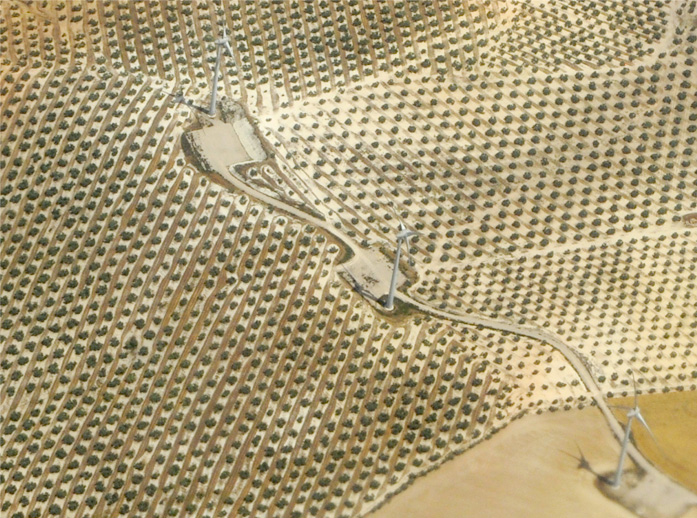 |
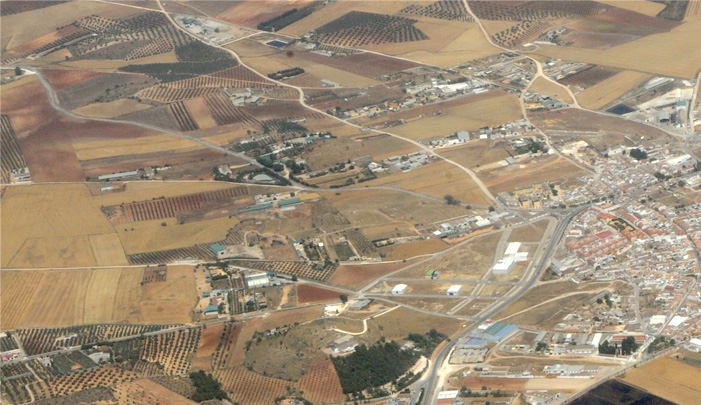 | At the edge of this city, the olive grove patterns were still the common signature. |
This shows a lake with a dam and then a constructed reservoir above. I believe it is a pump-storage unit for power generation. Off-peak power from the dam pumps water to the higher reservoir to provide the option of hydroelectric power from it when needed. 3:18pm | 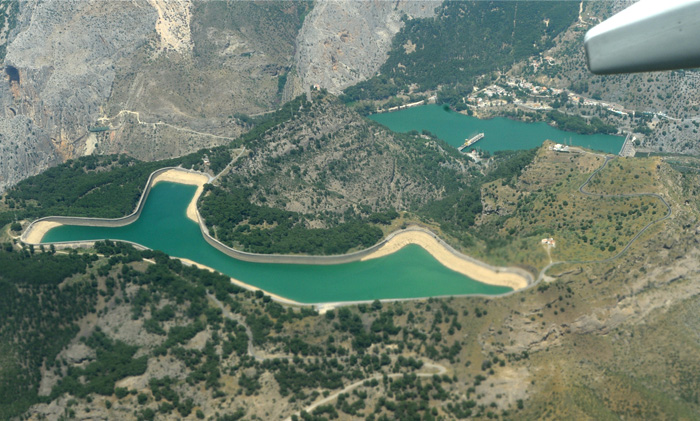 |
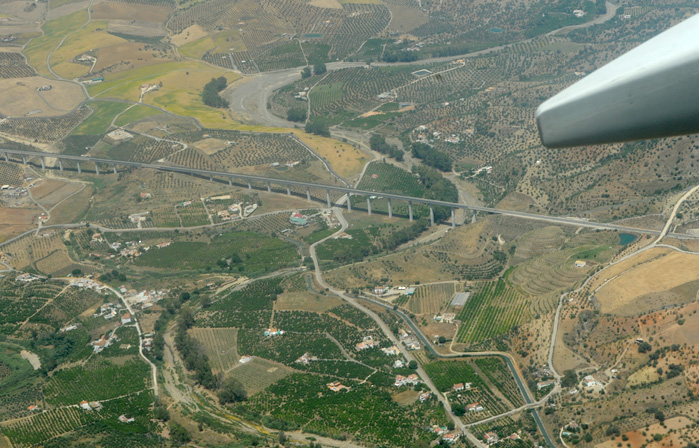 | I think this is a bridge on one of the Autovias or A-series highways, maybe near the intersection of A-92 and A-45 some 40-50 miles north of Malaga. |
This appears to be a reservoir atop a hill for watering the olive trees on the slopes. 3:21pm |  |
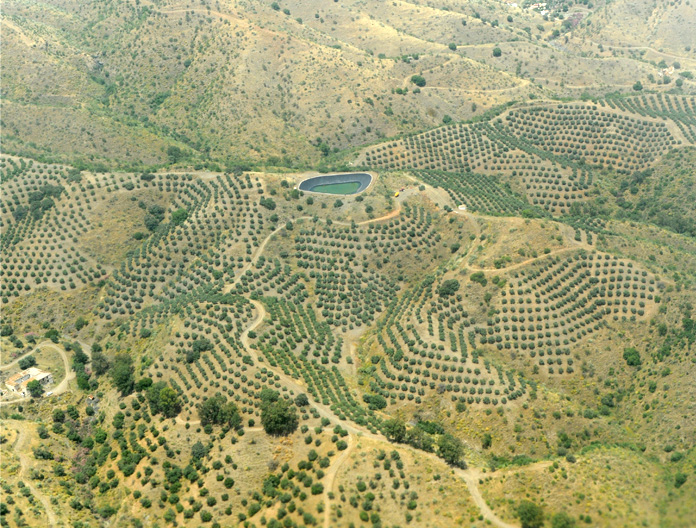 | Another example of a hilltop reservoir surrounded by olive trees. |
Approaching urban Malaga, there is still evidence of olive groves. 3:22pm. | 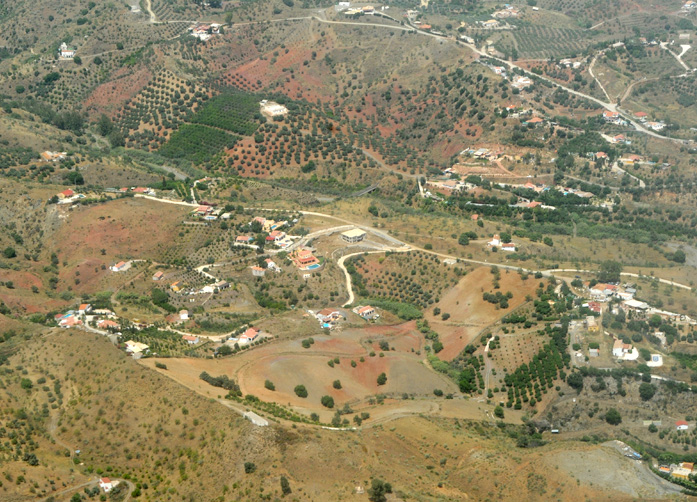 |
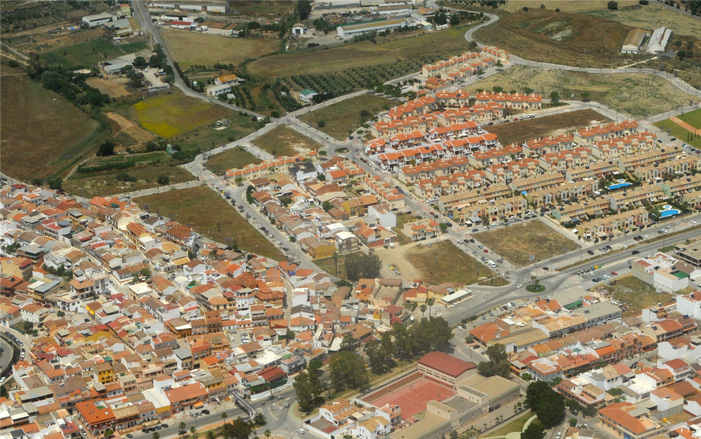 | Urban Malaga, but I still see an olive grove. 3:23pm |
Landing approach, flaps down, one minute from touchdown, and over ... olives! |  |
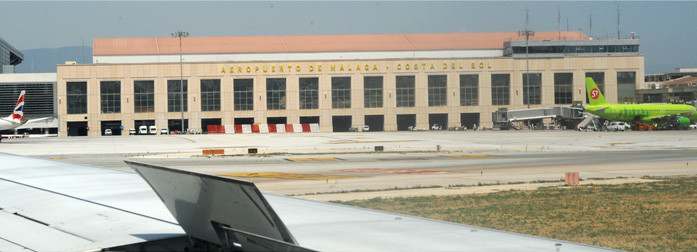 | On the ground at the Aeropuerto de Malaga, Costa del Sol, at 3:26pm. |
At the Malaga airport we were met by friendly lady with wheelchair for Brenda. Chris immediately got into friendly conversation with her in Spanish. Regulations required her to accompany us through customs. She led us to baggage pickup and we zipped right through customs - the agent asked Chris if we were carrying anything agricultural, I think, and with that answer and the presence of the lady, he waved us right through.
She took us to the Avis counter and we rented the car.
The car's displays were multilingual, so it took us a while to get them in English. Then couldn't get the GPS to work. Left and got to the AP-7, and I mistakenly stayed on the AP-7 rather than the coastal A-7 and we chewed up a half hour finding a way over to the A-7. Found the Riviera del Sol exit that we had been instructed to take, and must have wandered 30 minutes around and around until Brenda's phone gps got us to the totally unlabeled Grangefield Oasis Club. At the point where the gps said "you have arrived at the destination", we stopped, but saw no evidence of the Grangefield Oasis Club. There was a tour bus there, and Chris asked the driver if the Grangefield Oasis Club was around there, and he pointed us to a set of flags down the street which he said was the entrance to the Club. Sure enough, once we had walked down the stairs and toward a small building which was the welcome center, we finally saw a small sign that said Grangefield Oasis Club. We had to show our passports to check in. That all took us until about 8 pm and I was absolutely exhausted. I went promptly to bed and Brenda followed soon after. Chris had found some local muchachos to play soccer with on an empty lot across the street, and then watched television for a while.
Sunday, May 28, 2017
A good night's sleep helped us recover from the absolutely exhausting day yesterday. Chris was still sleeping, so about 9:30 Brenda and I went down the hill to where the market was near the A-7. It was very straightforward once we got the directions from Grangefield. It was closed on Sunday, but there was a restaurant just up the street and we decided to try breakfast there. We encountered two British ladies and talked with them on the street. They were interested in breakfast as well, so we joined at a table and had a delightful conversation with them. They only had the clothes on their backs because of the major crisis at Heathrow Airport, London, yesterday and hadn't gotten their luggage. It took them 12 hours for the normal 2 1/2 hr flight from Heathrow. The Washington Post described it as a "catastrophic computer outage" that affected British Airways. One interesting coincidence was that one of the British ladies had been born on Fiji since her father was in the British Foreign Service. I had just sent a DVD of HyperPhysics to Vanuatu, which is an island group close to Fiji - she could even correct my pronunciation of it. How likely is that - to run into someone in Spain who was very familiar with a place I had to look up on the map?!At the next table was a couple from DC who were going to be married in Granada next week with 30 family members making the trip for it.
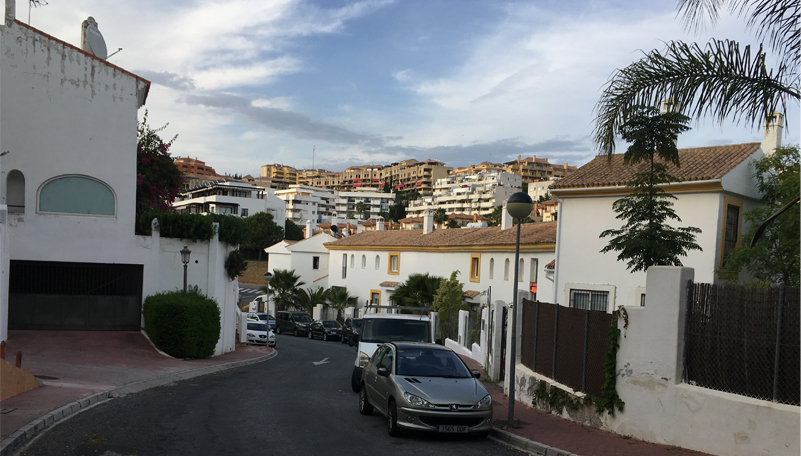
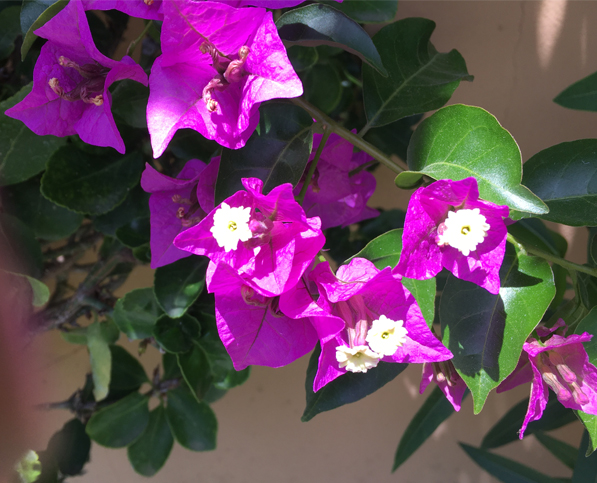 | Above is the Calle Opalo that ran in front of the Grangefield Oasis Club. Opalo is a one-way street, so this is the view of the direction that approaches the Club. We found the neat terraces of attached houses up the mountainside to be attractive. Adding to the local beauty was lots of bougainvillea. |
There were several varieties of hibiscus on the Club property. | 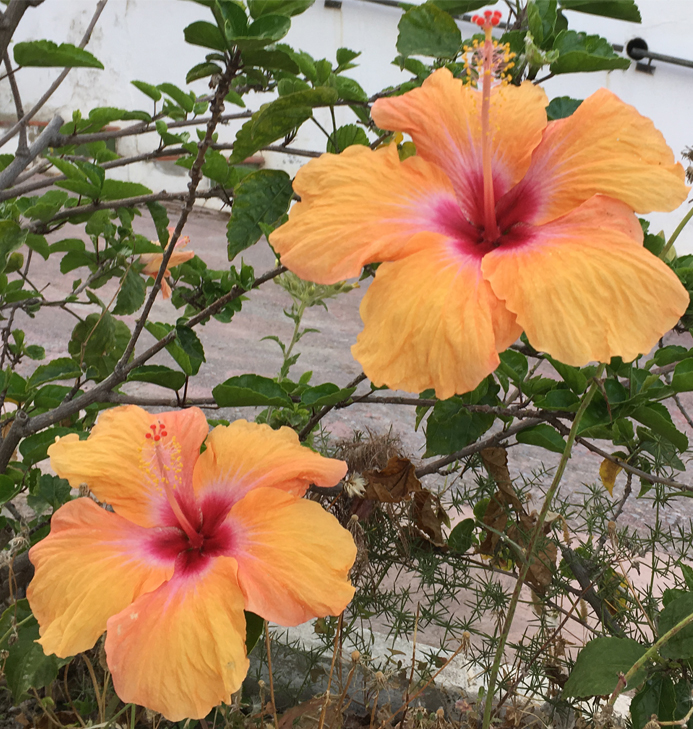 |
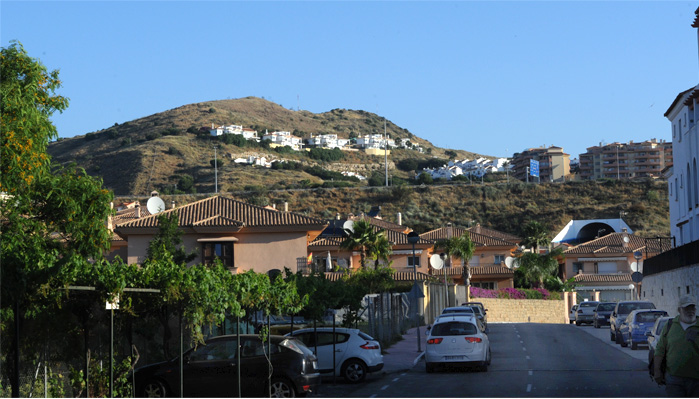 | This is the view down Calle Opalo in the direction we traveled when we left our accommodations. The roadway you can see about halfway up the mountain is the approach to the AP-7 highway, so we went that short distance up to the AP-7 many times. |
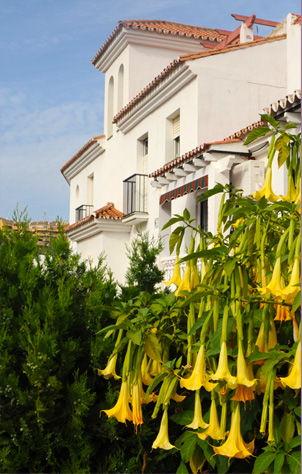 | 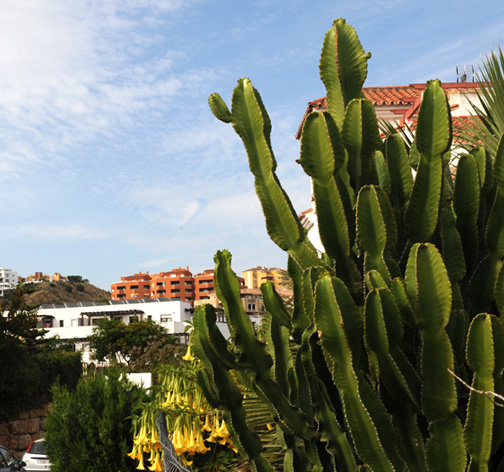 |
I focused on this plant with flowers like yellow trumpets to show some of the housing in view from Calle Opalo which ran right by our unit at Grangefield.
Monday, May 29, 2017
The Grangefield Oasis Club had a nice restaurant where they served buffet-style meals, so we had a nice buffet breakfast. The Club was on Opalo Street, and we then turned right on Esmeralda and then right on the Avenida del Golf to get to the bottom of the hill where the shops were. We got groceries and used the atm and currency exchange, and bought a night light and usb charger for the Spanish electrical plug. Made another run up Avenida de Espana and again couldn't find the Monte Paraiso street where the other housing is located. We made the loop around Avenida de Espana and back on to A7, looped over to return on A7, took the Calahonda exit and followed again the meandering path where we were led by the GPS. It brings us from the top down Esmeralda to Opalo.
 | The grocery shopping was interesting in the little grocery at the bottom of the Avenida del Golf. We looked in vain for peanut butter, but an employee showed us where there had been a few small containers. |
Certainly there was a lot of tile work in this area. Brenda is on the stairway to the second floor of this mall close to where the grocery store was. It was surprising to see such nice tile used on stairs like this. | 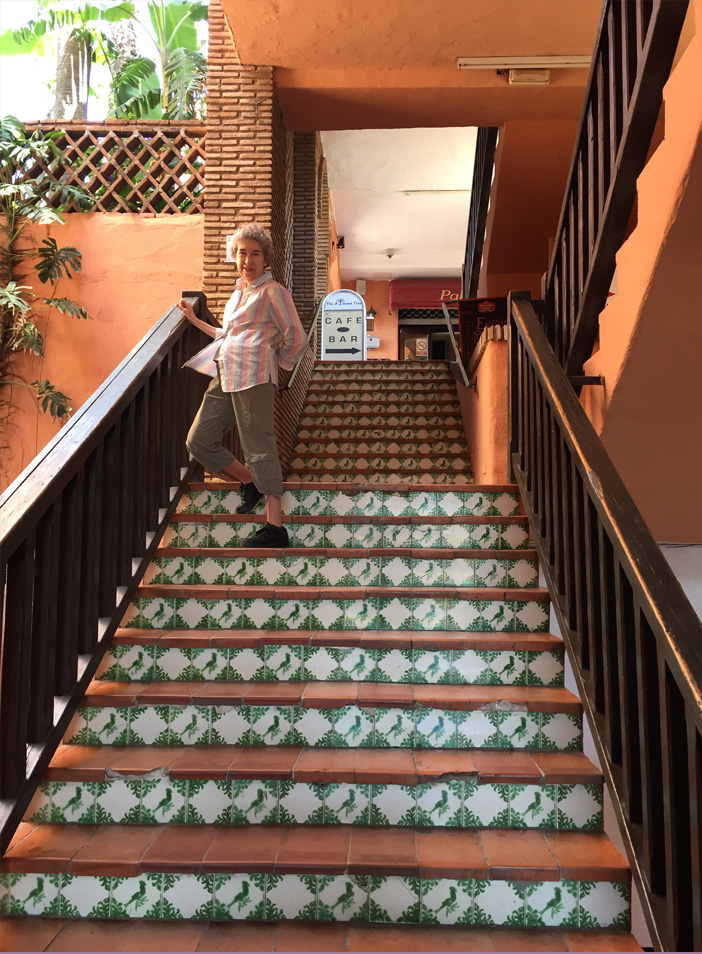 |
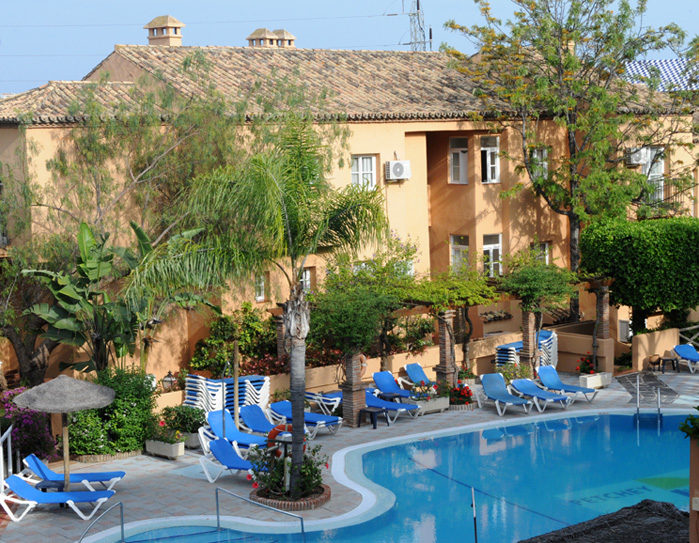 | This is the view of the resort pool from our balcony. The pool was well used - it appeared that some guests really came for the pool did little traveling about. |
This is our little Opal car, parked on Calle Opalo beside the building in which our rooms were - on the second level. As discussed above, you would look in vain for any sign that indicated that this is the Grangefield Oasis Club. But we now knew the streets we needed to get down to the shops and the A-7 highway. |  |
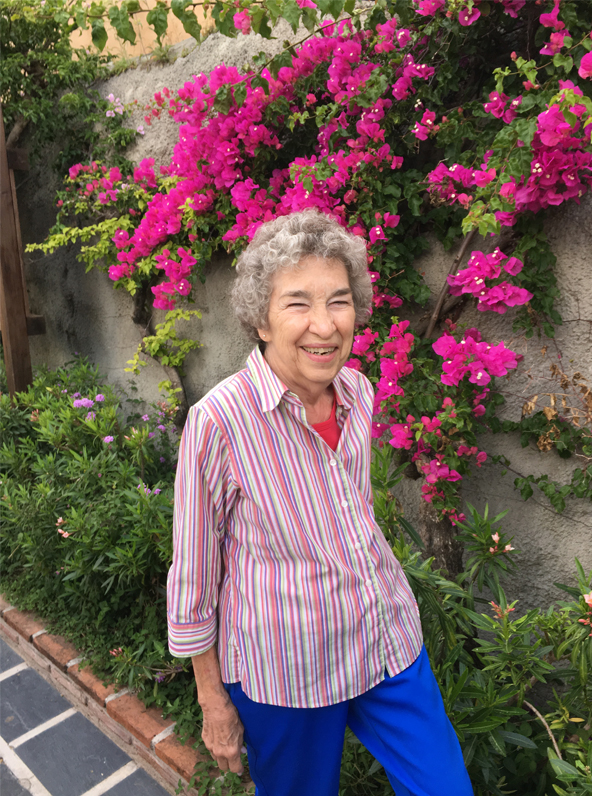 | We had some time to relax on Monday and Brenda spent some time by the nice pool. These nice bouganvilla were alongside the pool |
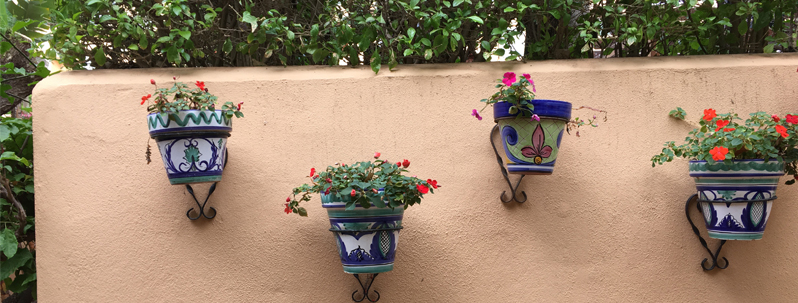
 | The walls around the pool had these attractive pots of flowers suspended on them. |
The stair risers at Grangefield were made of tile, so the stairways made a nice place for photos. Chris took this photo of Rod and Brenda. 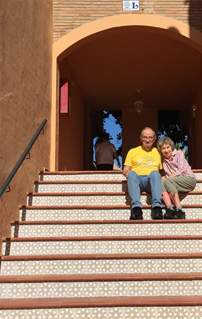 Our unit was at the end of this building. We had a similar stairway, but about half this width. | 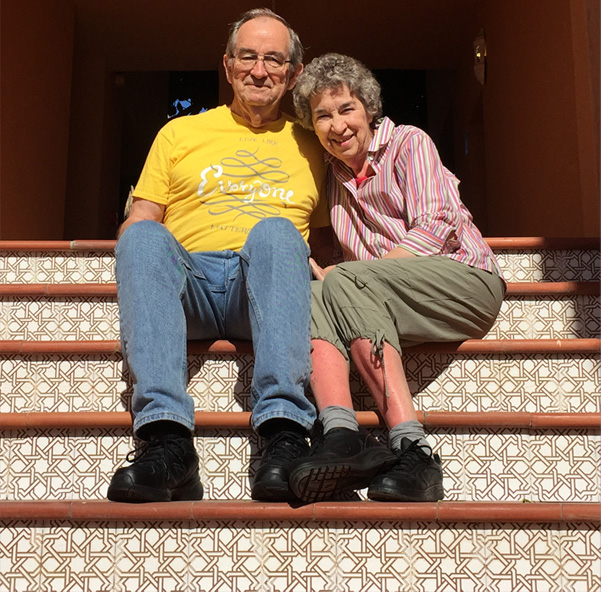 |
This is a view of some of the housing units of the Grangefield Oasis Club, similar to the one we were in. This is taken from the area of the pool restaurant. Note the little air conditioning units on the walls - they were standard for the area, but not very effective. Fortunately it got cool at night and we had the sea breeze. | 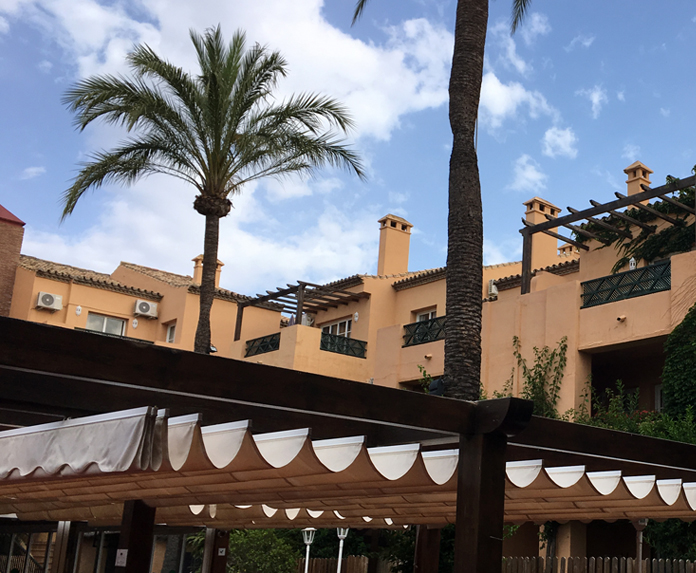 |
| Traveling to Seville |
2017